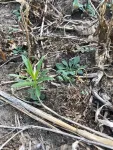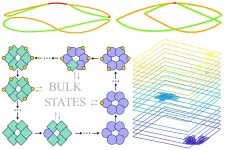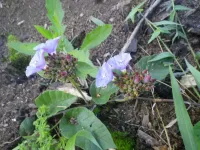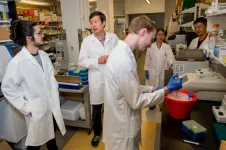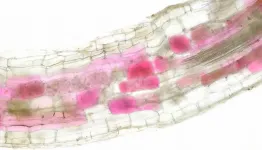Brain-repair discovery could lead to new epilepsy treatments
2021-07-23
(Press-News.org) University of Virginia School of Medicine researchers have discovered a previously unknown repair process in the brain that they hope could be harnessed and enhanced to treat seizure-related brain injuries.
Common seizure-preventing drugs do not work for approximately a third of epilepsy patients, so new and better treatments for such brain injuries are much needed. UVA's discovery identifies a potential avenue, one inspired by the brain's natural immune response.
Using high-powered imaging, the researchers were able to see, for the first time, that immune cells called microglia were not just removing damaged material after experimental seizures but actually appeared to be healing damaged neurons.
"There has been mounting generic support for the idea that microglia could be used to ameliorate seizures, but direct, visualized evidence for how they could do this has been lacking," said researcher Ukpong B. Eyo, PhD, of UVA's Department of Neuroscience, the UVA Brain Institute and UVA's Center for Brain Immunology and Glia (BIG). "Our results indicate that microglia may not be simply clearing debris but providing structural support for neuronal integrity that may have implications even beyond the scope of seizures and epilepsy."
A Surprising Response to Seizures
The new findings come from a collaboration of scientists at UVA, Mayo Clinic and Rutgers University. They used an advanced imaging technique called two-photon microscopy to examine what happened in the brains of lab mice after severe seizures. What they saw was strange and unexpected.
Rather than simply cleaning up debris, the microglia began forming pouches. These pouches didn't swallow up damaged material, as many immune cells do. Instead, they began tending to swollen dendrites - the branches of nerve cells that transmit nerve impulses. They weren't removing, the scientists realized; they appeared to be healing.
These odd little pouches - the scientists named them "microglial process pouches" - stuck around for hours. They often shrank, but they were clearly doing something beneficial because the dendrites they targeted ended up looking better and healthier than those they didn't.
"We did not find microglia to be 'eating' the neuronal elements in this context," Eyo said. "Rather, we saw a strong correlation between these interactions and a structural resolution of injured neurons suggestive of a 'healing' process."
The new insights into the brain's immune response points scientists in promising new directions. "Although these findings are exciting, there is yet a lot to follow-up on them. For example, the precise mechanisms that regulate the interactions remain to be identified. Moreover, at present, the 'healing' feature is suggested from correlational results and more definitive studies are required to certify the nature of the 'healing,'" Eyo said. "If these questions can be answered, they will provide a rationale for developing approaches to enhance this process ... in seizure contexts."
Eyo has already received two grants totaling almost $5 million from the National Institutes of Health to continue his study of microglia. The funding will allow him to study how the immune cells help regulate vascular function, which could be important in diseases such as Alzheimer's, and their role in brain-hyperactivity disorders such as febrile seizures that can trigger epilepsy.
"With this new funding, we are eager to clarify roles for microglia in seizure disorders and vascular function," he said. "UVA's continued investment is neuroscience research provides a suitable home for our lab's research."
INFORMATION:
Findings Published
The researchers have published their findings in the scientific journal Cell Reports. The research team consisted of Eyo, Koichiro Haruwaka, Mingshu Mo, Antony Brayan Campos-Salazar, Lingxiao Wang, Xenophon S. Speros IV, Sruchika Sabu, Pingyi Xu and Long-Jun Wu.
The research was supported by National Institutes of Health grants R01NS088627, R01NS112144 and K22N84392. Eyo's new NIH grants are R01NS119243 and R01NS122782
To keep up with the latest medical research news from UVA, subscribe to the Making of Medicine blog at http://makingofmedicine.virginia.edu.
[Attachments] See images for this press release:

ELSE PRESS RELEASES FROM THIS DATE:
2021-07-23
WESTMINSTER, Colorado - July 23, 2021 - Horseweed is a serious threat to both agricultural crops and natural landscapes around the globe. In the U.S., the weed is prolific and able to emerge at any time of the year.
Fall emerging horseweed overwinters as a rosette, while spring emerging horseweed skips the rosette stage and grows upright. In some instances, both rosette and upright plants emerge simultaneously in mid-summer. These unpredictable growth patterns create challenges for growers as they try to develop an appropriate weed management plan.
In a study featured in the journal Weed Science, a team from Michigan State University explored whether environmental cues could be used to predict horseweed growth ...
2021-07-23
A research team led by Dr Rosario Delgado from the UAB Department of Mathematics, in collaboration with the Hospital de Mataró, developed a new machine learning-based model that predicts the risk of mortality of intensive care unit patients according to their characteristics. The research was published in the latest edition of the journal Artificial Intelligence in Medicine, with a special mention as a "Position paper".
Under the framework of Artificial Intelligence, machine learning allows a model to gain knowledge based on the information provided by available ...
2021-07-23
When can we say that a certain property of a system is robust? Intuitively, robustness implies that, even under the effect of external perturbations on the system, no matter how strong or random, said property remains unchanged. In mathematics, properties of an object that are robust against deformations are called topological. For example, the letters s, S, and L can be transformed into each other by stretching or bending their shape. The same holds true for letters o, O, and D. However, it is impossible to turn an S into an O without a discontinuous operation, such as cutting the O apart or sticking the two ends of the S together. Therefore, we say that the letters s, S and L have the same topology - as do the letters o, O and D - ...
2021-07-23
Chemotherapy has helped make acute lymphoblastic leukemia (ALL) one of the most survivable childhood cancers. Now, researchers working in the U.S., Germany and China have shown how chemotherapy drugs called thiopurines can lead to mutations that set patients up for relapse. The work appears today in the journal Nature Cancer.
The research provides the first direct genomic and experimental evidence in pediatric cancer that drug-resistant mutations can be induced by chemotherapy and are not always present at diagnosis.
"The findings offer a paradigm shift in understanding how drug resistance develops," said Jinghui Zhang, Ph.D., Department of Computational Biology chair at St. Jude Children's Research Hospital. "The ...
2021-07-23
Rivers are lifelines for many countries. They create valuable ecosystems, provide drinking water for people and raw water for agriculture and industry. In the Global South in particular, there is strong competition for access to freshwater resources. The increasing use of hydropower has recently intensified this competition further.
Take Ethiopia, for example: when the country began filling the mega-?dam Gibe III on the Omo River in 2015, downstream users saw a drop in water volumes. Natural flooding declined, reducing the volume of fertile mud washed onto the floodplain. The level of Kenya's Lake Turkana, into which the Omo flows, fell temporarily by two metres, resulting in significant consequences for people and agriculture.
Addressing ...
2021-07-23
Scientists have identified five new plant species in the Bolivian Andes.
The species are all part of the genus Jacquemontia, which are twining or trailing plants with pretty blue flowers.
With rapid biodiversity loss taking place across South America and worldwide, identifying plant species is a vital step towards protecting them.
The new study, which classifies and describes the 28 Jacquemontia species now known to live in Bolivia and Peru, was carried out by the universities of Exeter and Oxford, and the Royal Botanic Gardens, Kew.
"Many plant species have not been identified and classified, especially in the tropics," said Rosie Clegg, of the University of Exeter and Kew.
"If you don't know what a species is, you can't ...
2021-07-23
Most children with a mental health disorder are not receiving services to address their needs--according to a new study from researchers at Simon Fraser University's Children's Health Policy Centre. Their research was published this week in the journal Evidence-Based Mental Health.
Researchers found that of the one in eight children (12.7 per cent) who experience a mental disorder, less than half (44.2 per cent) receive any services for these conditions.
"We have illuminated an invisible crisis in children's mental health and unacceptable service shortfalls in high-income countries -- including in Canada -- to a degree that violates children's rights," says study author Charlotte Waddell, ...
2021-07-23
After gaining world attention by 'unboiling' egg protein, Flinders University scientists have now used an Australian-made novel thin film microfluidic device to manipulate Beta-lactoglobulin (β-lactoglobulin), the major whey protein in cow's, sheep's and other mammals.
The so-called Vortex Fluidic Device has previously been used in an array of experiments to successfully 'un-boil' egg protein and even break the molecular bonds of one of the world's hardest material, carbon nanotubes.
In the latest application, published in Molecules, College of Science and Engineering experts have combined the capabilities of the VFD with a new form of biosensor called TPE-MI, which is an aggregation-induced emission luminogen (AIEgen).
"In the human body, protein folding is ...
2021-07-23
The human body is essentially made up of trillions of living cells. It ages as its cells age, which happens when those cells eventually stop replicating and dividing. Scientists have long known that genes influence how cells age and how long humans live, but how that works exactly remains unclear. Findings from a new study led by researchers at Washington State University have solved a small piece of that puzzle, bringing scientists one step closer to solving the mystery of aging.
A research team headed by Jiyue Zhu, a professor in the College of Pharmacy and Pharmaceutical Sciences, recently identified a DNA region known as VNTR2-1 that appears to drive the activity of the telomerase gene, which has been shown to prevent ...
2021-07-23
Almost all crop plants form associations with a particular type of fungi - called arbuscular mycorrhiza fungi - in the soil, which greatly expand their root surface area. This mutually beneficial interaction boosts the plant's ability to take up nutrients that are vital for growth.
The more nutrients plants obtain naturally, the less artificial fertilisers are needed. Understanding this natural process, as the first step towards potentially enhancing it, is an ongoing research challenge. Progress is likely to pay huge dividends for agricultural productivity.
In a study published in the journal PLOS Biology, researchers used the bright red pigments of beetroot - called betalains - to visually track soil fungi as they colonised plant roots in a living plant.
"We can now ...
LAST 30 PRESS RELEASES:
[Press-News.org] Brain-repair discovery could lead to new epilepsy treatments

